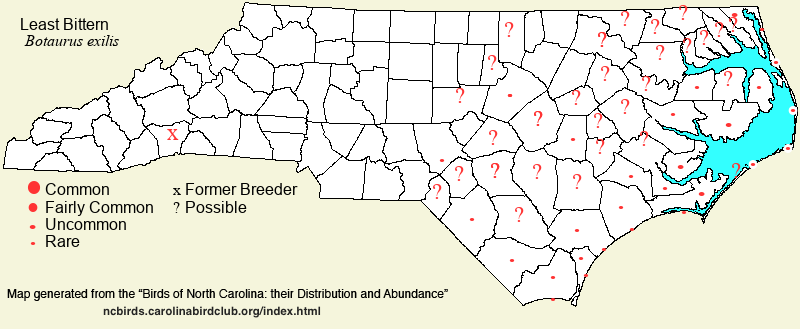 |  |
|
Least Bittern - Botaurus exilis ARDEIDAE Members: | Search Common: Search Scientific: |
|
|
|||||||
| General Comments | The Least Bittern is just as shy as its larger cousin, the American Bittern, but because it is much smaller, it tends to be less often seen. Unlike that species, which is quite rare as a breeder in North Carolina, the Least Bittern nests in moderate numbers, at least locally, in our freshwater and brackish marshes, mainly near the coast. However, it is mysteriously scarce as a breeder on the Outer Banks, where the fresh and brackish marshes at well known sites on Bodie and Pea islands, and at Cape Hatteras, seem devoid of them. As with the American Bittern, there seems to have been a decline in numbers of Least Bitterns, though the extent of suitable marshes does not appear to have been diminished in recent years. Most birds are found in taller freshwater marshes, especially in cattails, but at times they can be found in brackish marshes. In recent years, a few Least Bitterns have been seen in winter near the coast, but currently it is not considered a winter resident species, unlike the American Bittern. | ||||||
| Breeding Status | Breeder | ||||||
| NC BRC List | Definitive | ||||||
| State Status | SC | ||||||
| U.S. Status | |||||||
| State Rank | S3B | ||||||
| Global Rank | G5 | ||||||
| Coastal Plain | Summer resident and migrant; a handful of winter records. Occurs nearly throughout the Tidewater and coastal areas, but generally rare to uncommon and local as a breeder; fairly common at only a few sites, such as at Great Marsh in Mackay Island NWR, Pamlico Point marshes, and Cedar Island NWR. Farther inland (away from Tidewater), very rare to rare and erratic summer resident, nowhere consistently from summer to summer. Mainly early Apr to mid-Oct, and very rarely into Dec. Very rare in midwinter (but seldom overwinters); records slowly increasing at that season, near and along the coast -- including far-northern Mackay Island NWR (Currituck). Peak counts: a remarkable 62 at Cedar Island NWR, 3 Jul 2016; 44 (many of which were juveniles), at that site, 9 Jul 2017; 24 there, 28 Jun 2015; 20, Carteret, late May 2011; 18, Pamlico, 15 Jul 1984. A tally of three calling birds in eastern Moore on 17 Jun 2023 was a notable number for a far inland site, and is clearly suggestive of nesting. | ||||||
| Piedmont | Transient and scarce summer resident. Rare (and easily overlooked) transient, and rare and local breeder, mainly in the extreme eastern counties (Wake, Durham, and Chatham); formerly nested in small numbers at Lake Wheeler (Wake), but status since about 1975 not known. However, two birds were noted calling at Flat River impoundment (Durham) on several dates in late May 2020, and one was calling there from 2-11 Jun 2022. One was one at Chantilly Park (Mecklenburg) on several dates at the end of spring 2020. Counts of 4-6 calling birds at Harris Lake (Wake) on 23-24 Apr 2016 clearly indicate nesting there. One at Tanglewood Park (Forsyth), 7-26 Jun 2017 may have been a breeding bird; as might have been one along the Rocky River (Cabarrus) on 11 and 25 Jul 2021, and again from 5-8 Jun 2022. Mainly late Apr to early Oct; one winter report -- 1, Kernersville, 31 Dec 1965. Peak counts: ? | ||||||
| Mountains | Casual to very rare transient, and perhaps has nested on rare occasions in the Hendersonville area. Most records from Henderson; early May to early Oct. One at Valle Crucis (Watauga) on 19 May 2019, one photographed near Hot Springs (Madison) on 7 Sep 2020, and one at Boone (Watauga) on 11 May 2024 are among the only records for the central and northern mountains. Exceptionally late was one seen at Ecusta Pond (Transylvania) on 29 Oct 2023. A heard-only report with an audio-recording is hopefully correct, from Owen Park in Swannanoa (Buncombe) on 28 Dec 2023, and heard only again there on 7 Apr 2024. Peak count: 10, Hendersonville, both summer 1935 and 1936. | ||||||
| Finding Tips |
Most of the better sites are difficult for birders to reach. It is reportedly common as a breeder at the Pamlico Point impoundments (boat required to reach), Lake Ellis Simon (private), and at Great Marsh at Mackay Island NWR (ferry ride or drive into Virginia to reach). The species nests around the margins of some lakes and ponds at Twin Lakes at Sunset Beach, at Orton Plantation, and scattered other sites. The best bets to look and listen for the birds are from NC 12 through Cedar Island NWR and from NC 615 at Mackay Island refuge. ** | ||||||
| Attribution | LeGrand[2025-04-21], LeGrand[2024-08-05], LeGrand[2024-05-13] | ||||||
| NC Map Map depicts all counties with a report (transient or resident) for the species. | Click on county for list of all known species. |
| NC Breeding Season Map Map depicts assumed breeding season abundance for the species. |  |